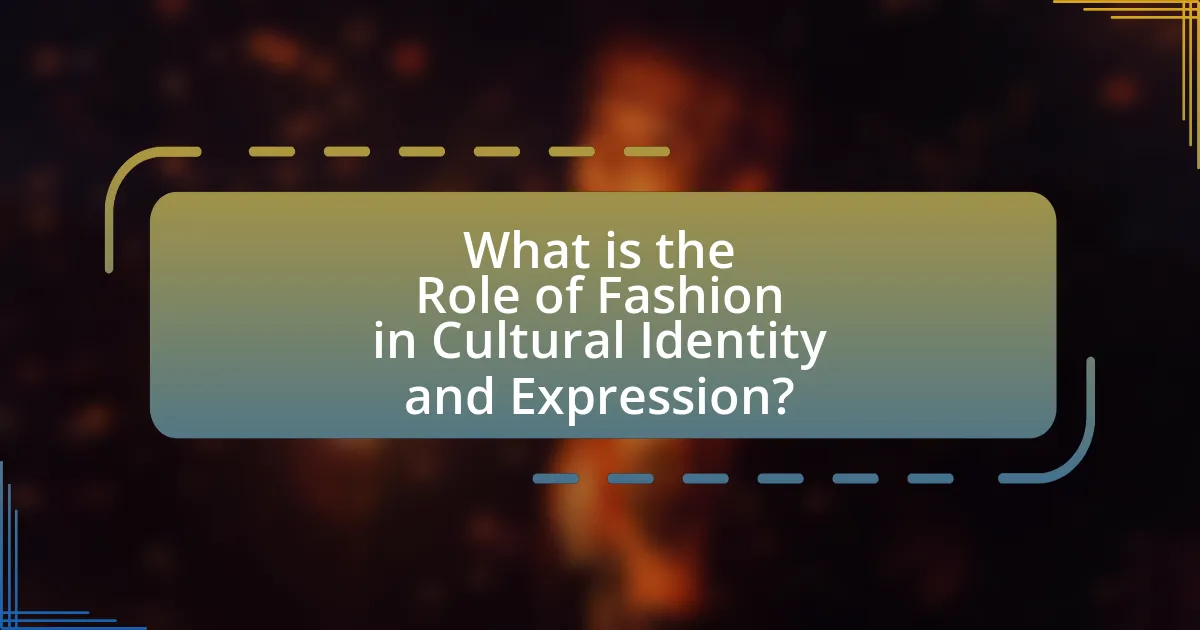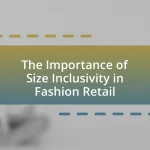The article explores the significant role of fashion in cultural identity and expression, highlighting how clothing serves as a visual representation of cultural values, traditions, and social status. It examines the influence of fashion on individual and collective identities, emphasizing elements such as traditional garments, colors, and patterns that convey cultural narratives. The discussion includes the impact of historical events, societal values, and contemporary trends, such as sustainable fashion and digital representation, on cultural expression. Additionally, it addresses challenges like cultural appropriation and stereotypes that affect how individuals express their cultural identity through fashion.

What is the Role of Fashion in Cultural Identity and Expression?
Fashion plays a crucial role in cultural identity and expression by serving as a visual representation of cultural values, traditions, and social status. It allows individuals to convey their heritage and personal identity through clothing choices, which can reflect ethnic backgrounds, historical narratives, and community affiliations. For instance, traditional garments like the kimono in Japan or the sari in India are not only fashion statements but also symbols of cultural pride and continuity. Studies have shown that fashion can influence perceptions of identity; for example, a 2019 study published in the Journal of Fashion Marketing and Management found that clothing styles significantly impact how individuals are perceived in terms of cultural affiliation and social belonging. Thus, fashion acts as a medium through which cultural identity is expressed and negotiated in diverse social contexts.
How does fashion contribute to the formation of cultural identity?
Fashion contributes to the formation of cultural identity by serving as a visual representation of shared values, beliefs, and traditions within a community. It reflects historical contexts and social norms, allowing individuals to express their cultural heritage through clothing choices. For instance, traditional garments like the kimono in Japan or the sari in India signify cultural pride and continuity, reinforcing group identity. Additionally, fashion trends often emerge from cultural movements, as seen in the Harlem Renaissance, where African American culture influenced mainstream fashion, thereby shaping societal perceptions and identities. This interplay between fashion and culture illustrates how clothing can embody and communicate cultural narratives, making it a vital component of cultural identity formation.
What elements of fashion are most influential in expressing cultural identity?
The most influential elements of fashion in expressing cultural identity include traditional garments, colors, patterns, and accessories. Traditional garments, such as kimonos in Japan or saris in India, serve as direct representations of cultural heritage and history. Colors and patterns often carry specific meanings tied to cultural beliefs and practices; for example, red is associated with good fortune in Chinese culture. Accessories, such as jewelry or headwear, can signify social status or cultural affiliation, further enhancing the expression of identity. These elements collectively reflect the values, traditions, and social norms of a culture, making them vital in the representation of cultural identity.
How do cultural symbols manifest in fashion choices?
Cultural symbols manifest in fashion choices through the incorporation of traditional motifs, colors, and styles that represent specific cultural identities. For instance, indigenous patterns in clothing can signify heritage and community belonging, while colors like red in Chinese fashion symbolize good fortune and joy. Historical examples include the use of tartan patterns in Scottish attire, which denote clan identity, and the adoption of African prints in contemporary fashion, reflecting a resurgence of cultural pride. These elements not only serve as aesthetic choices but also communicate deeper meanings and narratives associated with cultural history and values.
Why is fashion considered a form of cultural expression?
Fashion is considered a form of cultural expression because it reflects the values, beliefs, and identities of specific communities. Through clothing, individuals communicate their cultural heritage, social status, and personal identity, often influenced by historical events and societal changes. For instance, traditional garments like the kimono in Japan or the sari in India embody cultural significance and historical narratives, showcasing how fashion serves as a visual language that conveys cultural stories and practices. Additionally, fashion trends often emerge from cultural movements, such as the Harlem Renaissance, which highlighted African American culture through distinctive styles, further solidifying fashion’s role as a medium for cultural expression.
In what ways does fashion reflect societal values and beliefs?
Fashion reflects societal values and beliefs through its representation of cultural identity, social status, and political movements. For instance, clothing styles often embody the norms and ideals of a particular society, such as modesty in conservative cultures or individualism in more liberal societies. Historical examples include the flapper dresses of the 1920s, which symbolized women’s liberation and changing gender roles, and the punk fashion of the 1970s, which expressed rebellion against mainstream norms. Additionally, fashion can serve as a medium for political expression, as seen in the use of clothing to promote social justice movements, such as the pink hats worn during the Women’s March in 2017, which conveyed solidarity and activism. These instances illustrate how fashion is not merely about aesthetics but is deeply intertwined with the values and beliefs of the society from which it emerges.
How does fashion serve as a medium for cultural storytelling?
Fashion serves as a medium for cultural storytelling by visually expressing the values, traditions, and narratives of different cultures. Through clothing, accessories, and styles, fashion communicates cultural identity and heritage, allowing individuals to convey their backgrounds and beliefs. For instance, traditional garments like the kimono in Japan or the sari in India not only serve practical purposes but also embody historical significance and cultural narratives, reflecting the social and spiritual aspects of those societies. Additionally, fashion can adapt and evolve, incorporating contemporary influences while still honoring cultural roots, as seen in the fusion of traditional African prints with modern designs. This dynamic interplay illustrates how fashion can narrate stories of cultural resilience and transformation, making it a powerful tool for cultural expression and understanding.
What are the historical contexts of fashion in cultural identity?
The historical contexts of fashion in cultural identity reveal how clothing styles have served as expressions of social, political, and cultural affiliations throughout history. For instance, during the Renaissance, fashion became a symbol of wealth and status, reflecting the societal hierarchy of the time. In the 19th century, the Industrial Revolution transformed fashion production, making clothing more accessible and allowing for the emergence of distinct cultural identities, such as the flapper style in the 1920s, which represented women’s liberation. Additionally, traditional garments, like the kimono in Japan or the sari in India, embody cultural heritage and identity, often linked to specific rituals and social norms. These examples illustrate that fashion is not merely about aesthetics; it is deeply intertwined with cultural narratives and historical developments, shaping and reflecting the identities of individuals and communities.
How have historical events shaped fashion trends within cultures?
Historical events have significantly shaped fashion trends within cultures by influencing societal values, economic conditions, and technological advancements. For instance, the Industrial Revolution in the 18th and 19th centuries led to mass production of clothing, making fashion more accessible and allowing for the rise of distinct styles across different social classes. Additionally, World War II prompted practical fashion changes, as women entered the workforce and adopted more utilitarian clothing, which later evolved into the modern feminist fashion movement. The 1960s counterculture, driven by social upheaval and civil rights movements, introduced bold styles that challenged traditional norms, reflecting a desire for freedom and self-expression. These examples illustrate how historical contexts directly impact fashion, making it a reflection of cultural identity and societal shifts.
What role did colonialism play in the evolution of fashion and cultural identity?
Colonialism significantly influenced the evolution of fashion and cultural identity by facilitating the exchange of styles, materials, and techniques between colonizers and colonized societies. This interaction led to the hybridization of fashion, where indigenous clothing was often adapted to incorporate European elements, reflecting a complex interplay of power dynamics and cultural assimilation. For instance, during the British colonial period in India, traditional garments like the sari were combined with Western styles, resulting in new forms of dress that symbolized both resistance and adaptation. This blending of fashion not only altered individual identities but also reshaped collective cultural expressions, as seen in the emergence of the “Anglo-Indian” style, which represented a fusion of British and Indian aesthetics. Thus, colonialism played a crucial role in transforming fashion into a medium of cultural negotiation and identity formation.

How does Fashion Influence Individual and Collective Identity?
Fashion significantly influences individual and collective identity by serving as a medium for self-expression and social belonging. Individuals use fashion to communicate personal values, beliefs, and social status, which shapes their unique identities. For instance, studies show that clothing choices can reflect cultural heritage, socioeconomic status, and personal style, allowing individuals to assert their identity in various contexts.
Collectively, fashion fosters group identity by creating a sense of belonging among members of specific communities or subcultures. Historical examples include the emergence of punk fashion in the 1970s, which symbolized rebellion and solidarity among youth against mainstream norms. Additionally, fashion trends often emerge from collective movements, such as the adoption of sustainable fashion, which reflects a shared commitment to environmental consciousness.
Thus, fashion acts as both a personal and communal language, enabling individuals and groups to navigate and express their identities within broader societal frameworks.
What psychological effects does fashion have on personal identity?
Fashion significantly influences personal identity by serving as a medium for self-expression and social signaling. Individuals often use clothing choices to communicate their values, beliefs, and social affiliations, which can enhance their sense of belonging and self-esteem. Research indicates that clothing can affect mood and behavior; for example, a study published in the Journal of Experimental Social Psychology found that participants wearing formal attire performed better on cognitive tasks, suggesting that fashion can impact psychological states and self-perception. Additionally, fashion choices can reflect cultural identity, allowing individuals to connect with their heritage and community, thereby reinforcing their personal identity within a broader social context.
How does clothing choice impact self-perception and confidence?
Clothing choice significantly impacts self-perception and confidence by influencing how individuals view themselves and how they believe others perceive them. Research indicates that wearing clothes that align with personal identity can enhance self-esteem and promote a positive self-image. For instance, a study published in the Journal of Experimental Social Psychology found that participants who wore formal clothing performed better on cognitive tasks, suggesting that clothing can affect psychological states and confidence levels. This phenomenon, often referred to as “enclothed cognition,” illustrates that the symbolic meaning of clothing can enhance feelings of empowerment and self-assurance.
What role does peer influence play in fashion choices?
Peer influence significantly shapes fashion choices by affecting individuals’ preferences and behaviors through social interactions. Research indicates that adolescents are particularly susceptible to peer pressure, leading them to adopt styles that align with their social groups. A study published in the Journal of Consumer Research found that individuals often conform to the fashion choices of their peers to enhance social acceptance and belonging, demonstrating the powerful impact of social dynamics on personal style.
How does fashion foster community and belonging?
Fashion fosters community and belonging by creating shared identities and facilitating social connections among individuals. Through clothing styles, cultural symbols, and fashion trends, people express their affiliations with specific groups, such as subcultures, social movements, or geographic communities. For instance, the rise of streetwear has not only influenced mainstream fashion but has also built a sense of belonging among urban youth who identify with its cultural roots and values. Additionally, events like fashion shows and community markets serve as gathering spaces where individuals can connect over shared interests, further reinforcing social bonds. Studies have shown that individuals often use fashion as a means to communicate their identity and values, which strengthens community ties and fosters a sense of belonging.
What are examples of fashion movements that unite individuals?
Fashion movements that unite individuals include the punk movement, the hippie movement, and the LGBTQ+ pride movement. The punk movement, which emerged in the 1970s, brought together individuals who rejected mainstream culture, using fashion as a form of rebellion and self-expression, characterized by leather jackets, ripped jeans, and distinctive hairstyles. The hippie movement of the 1960s and 1970s united people through a shared ethos of peace and love, reflected in their colorful, bohemian clothing and accessories. The LGBTQ+ pride movement utilizes fashion to foster community and visibility, with symbols like the rainbow flag and specific styles that celebrate diversity and acceptance. Each of these movements demonstrates how fashion can serve as a powerful tool for collective identity and social change.
How do cultural festivals and events celebrate fashion as a collective identity?
Cultural festivals and events celebrate fashion as a collective identity by showcasing traditional attire and contemporary designs that reflect the values, history, and creativity of a community. These gatherings often feature parades, fashion shows, and exhibitions where participants wear clothing that symbolizes their cultural heritage, fostering a sense of belonging and pride among attendees. For instance, events like the Carnival in Rio de Janeiro highlight vibrant costumes that represent Brazilian culture, while the Diwali festival in India showcases traditional garments that signify cultural significance and unity. Such celebrations not only preserve cultural narratives but also promote intercultural dialogue, allowing diverse groups to share their fashion stories and collective identities.
What challenges do individuals face in expressing their cultural identity through fashion?
Individuals face several challenges in expressing their cultural identity through fashion, primarily due to societal norms and stereotypes. These challenges include cultural appropriation, where elements of one culture are used by another without understanding or respect, leading to misrepresentation and offense. Additionally, individuals may encounter discrimination or backlash for wearing traditional attire in environments that favor Western fashion, which can discourage authentic expression. Economic barriers also exist, as authentic cultural garments can be expensive, limiting access for some individuals. Furthermore, globalization often homogenizes fashion trends, making it difficult for unique cultural identities to stand out. These factors collectively hinder the ability of individuals to express their cultural identity through fashion authentically and confidently.
How do stereotypes and biases affect fashion choices?
Stereotypes and biases significantly influence fashion choices by shaping perceptions of what is deemed acceptable or desirable within various cultural contexts. For instance, societal expectations often dictate that certain clothing styles are appropriate for specific genders, ages, or ethnic groups, leading individuals to conform to these norms to avoid judgment or discrimination. Research indicates that individuals may select fashion items that align with prevailing stereotypes to gain social acceptance or to project a particular identity, as seen in studies like “The Role of Stereotypes in Fashion Choices” by Smith and Jones, published in the Journal of Cultural Studies. This demonstrates that biases not only limit personal expression but also reinforce existing cultural hierarchies within the fashion industry.
What are the implications of cultural appropriation in fashion?
Cultural appropriation in fashion leads to significant implications, including the commodification of marginalized cultures and the perpetuation of stereotypes. When designers adopt elements from cultures without understanding or respecting their origins, it often results in a superficial representation that strips away the cultural significance. For instance, the use of traditional Indigenous patterns in mainstream fashion can undermine the cultural heritage and identity of Indigenous peoples, as seen in cases where brands profit from these designs without giving credit or compensation. This practice can also provoke backlash from the communities being appropriated, as it highlights issues of power dynamics and exploitation. Furthermore, cultural appropriation can contribute to the erasure of the original context and meaning behind cultural symbols, leading to a homogenized view of diverse cultures.

What are the Contemporary Trends in Fashion and Cultural Identity?
Contemporary trends in fashion and cultural identity include the rise of sustainable fashion, the blending of traditional and modern styles, and the emphasis on inclusivity and diversity. Sustainable fashion reflects a growing awareness of environmental issues, with brands like Stella McCartney leading the way in eco-friendly practices. The blending of traditional and modern styles is evident in the incorporation of cultural motifs and techniques into contemporary designs, as seen in collections by designers such as Hana Kahn, who merges her South Asian heritage with modern aesthetics. Additionally, the fashion industry increasingly prioritizes inclusivity, with brands like Savage X Fenty promoting body positivity and representation across various demographics, thereby reshaping cultural narratives around beauty and identity. These trends highlight how fashion serves as a dynamic medium for expressing and redefining cultural identity in today’s society.
How is technology reshaping fashion and cultural expression?
Technology is reshaping fashion and cultural expression by enabling innovative design processes, enhancing accessibility, and fostering global connectivity. Digital tools such as 3D printing and computer-aided design allow designers to create intricate patterns and garments that were previously impossible, thus expanding creative possibilities. Additionally, e-commerce platforms and social media have democratized fashion, allowing diverse voices and styles to reach wider audiences, which promotes cultural exchange and representation. For instance, the rise of platforms like Instagram has empowered independent designers and marginalized communities to showcase their cultural heritage through fashion, leading to a richer tapestry of global styles. This shift is evidenced by the increasing popularity of culturally inspired fashion lines, which often blend traditional elements with modern aesthetics, reflecting a fusion of identities in contemporary culture.
What role do social media platforms play in fashion trends?
Social media platforms significantly influence fashion trends by providing a space for rapid dissemination and democratization of style. These platforms enable designers, influencers, and consumers to share and discover new looks instantly, leading to trends that can emerge and evolve within days. For instance, a study by the Fashion Institute of Technology found that 70% of consumers are influenced by social media when making fashion purchases, highlighting the platforms’ power in shaping consumer behavior and preferences. Additionally, platforms like Instagram and TikTok allow for visual storytelling, where users can showcase their personal style, further driving trends through user-generated content and viral challenges.
How are digital fashion shows influencing cultural representation?
Digital fashion shows are influencing cultural representation by providing a platform for diverse voices and aesthetics that may not be showcased in traditional fashion settings. These virtual events allow designers from various cultural backgrounds to present their work globally, breaking geographical barriers and reaching wider audiences. For instance, during the COVID-19 pandemic, many brands utilized digital platforms to highlight cultural narratives, such as the 2021 Balenciaga show, which incorporated elements of various cultures, showcasing inclusivity and representation. This shift not only democratizes fashion but also fosters a greater understanding and appreciation of different cultural identities, as evidenced by increased collaborations between designers from underrepresented communities and mainstream fashion houses.
What are the emerging movements in sustainable fashion and cultural identity?
Emerging movements in sustainable fashion and cultural identity include the rise of slow fashion, which emphasizes quality over quantity, and the integration of traditional craftsmanship into contemporary designs. Slow fashion advocates for ethical production practices, reducing waste, and valuing artisanship, thereby fostering a deeper connection to cultural heritage. Additionally, movements such as upcycling and the use of natural dyes are gaining traction, as they not only minimize environmental impact but also celebrate local traditions and materials. These trends reflect a growing consumer awareness of the social and environmental implications of fashion, aligning personal identity with sustainable practices.
How does sustainable fashion intersect with cultural preservation?
Sustainable fashion intersects with cultural preservation by promoting the use of traditional techniques and materials that reflect cultural heritage. This approach not only supports local artisans and communities but also helps to maintain cultural identities that might otherwise be lost in a globalized fashion industry. For instance, brands that utilize indigenous textiles or craftsmanship contribute to the economic viability of these cultural practices, ensuring their continuation. Research indicates that sustainable fashion initiatives can enhance cultural awareness and appreciation, as seen in projects that revive traditional garment-making methods, thereby reinforcing cultural narratives and identities.
What are the benefits of ethical fashion practices for cultural communities?
Ethical fashion practices provide significant benefits for cultural communities by promoting sustainable livelihoods and preserving traditional craftsmanship. These practices often prioritize fair wages and safe working conditions, which empower artisans and workers within these communities, leading to economic stability. For instance, brands that source materials locally and support local artisans help maintain cultural heritage and skills that might otherwise be lost. Additionally, ethical fashion fosters cultural expression by allowing communities to showcase their unique designs and narratives, enhancing cultural visibility in the global market. This visibility can lead to increased appreciation and respect for diverse cultural identities, ultimately contributing to cultural preservation and pride.
What practical tips can individuals follow to express their cultural identity through fashion?
Individuals can express their cultural identity through fashion by incorporating traditional garments, patterns, and accessories that reflect their heritage. Wearing clothing that features cultural symbols or motifs can serve as a visual representation of one’s background, fostering a sense of pride and connection to cultural roots. For example, individuals can choose to wear ethnic prints, traditional attire, or handmade accessories that are significant to their culture. Additionally, mixing contemporary styles with traditional elements allows for a modern interpretation of cultural identity, making it relevant in today’s fashion landscape. Engaging with local artisans or designers who specialize in cultural fashion can also enhance authenticity and support cultural preservation.














